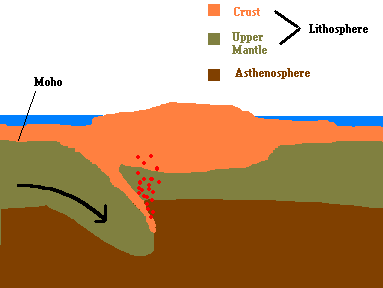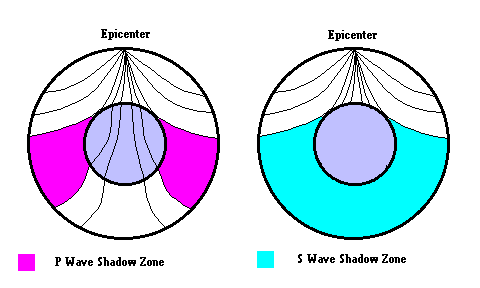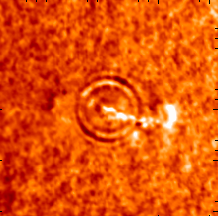

You learned in grade school that the earth consists of 4 layers: crust, mantle, outer & inner core.
For the most part, the mantle is completely inaccessible. The deepest hole drilled reached 12.2 km (7.6 miles), and this was the on continental crust (which, at the drill site of Kola was estimated to be 35 km thick). This project was abandoned because interior temperatures were much higher than expected. A project in the 1970s, called "Mohole" was designed to drill a hole completely through the much thinner oceanic crust and into the mantle. This project was never completed.
The only direct evidence of the Earth's interior is from rocks brought
up during volcanic eruptions, and from slabs of oceanic crust that have
been uplifted and exposed at the surface during the formation of mountain
belts. But these rocks only give us clues about the very top of the mantle
and only leave us guessing about what lies deep inside the earth.
Consequently, we must rely on indirect evidence to determine properties
of the Earth's interior.
Seismic waves are affected by the medium they are
traveling through. Two events are common when a seismic wave crosses a
boundary between rocks with different characteristics:

For example, "S Waves" are not capable of moving through a liquid. The seismic models (based on current data) suggest that the outer core is actually liquid.
Based in data collected, this is the model that emerges:
Crust - mostly silicate rock. Oceanic crust (basalt) is 8-11 km thick & continental crust (granite) is 25 - 90 km thick
The base of the crust is a compositional boundary that is indicated from a slight increase (6 km/sec to 8 km/sec) in seismic wave velocities. The boundary is known as the Mohorovicic Discontinuity or "Moho" in short. It was discovered by, Andrija Mohorovicic, following a large quake in Croatia in 1909. The Moho marks the boundary between the crust and the mantle and is marked by a change in composition.
Mantle - Believed to consist of peridotite, an olivine
silicate containing iron and magnesium (but no feldspars). It is
believed that there is a large scale circulation of material in the mantle
called convection cells. Driven by temperature differences and gravity,
details about these circulation patterns are not well understood.

At a depth of about 100 km there is a sudden decrease in both P and
S-wave velocities. The sudden drop in velocity indicates that the
rocks are very close to their melting point. The rocks at this depth
are either partially molten or so close that they behave like a plastic.
This boundary marks the base of the lithosphere (where rocks are
brittle) and the top of the asthenosphere (where rocks are plastic).
The lithosphere is composed of both crust and part of the upper mantle.
It is a brittle layer that makes up the plates in plate tectonics, and
appears to float and move around on top of the more ductile asthenosphere.
An abrupt increase in seismic wave velocities occurs at a depth of 670 km. It is believed that this layer represents a layer where the asthenosphere ends and the rocks become less plastic and more brittle.
Mantle-core boundary (Gutenberg Discontinuity - depth 2900 km) Another seismic discontinuity was discovered by Beno Gutenberg based on "P wave shadow zones" . Gutenberg (1914) realized that there were "zones" where P Waves did not appear. Based on this, he concluded a major boundary existed separating the mantle and the core. Later, the study of S Waves also showed shadow zones indicating that the outer core must be liquid (since S waves can not travel through liquids).

Outer Core - liquid iron (plus some nickel)
The core must be made of metals, not silicates. If the crust is granitic/basaltic (2.7-3.0 g/cm3) and the mantle peridotite (3.3 g/cm3), then the core must be very dense (10 -13 g/cm3) in order to arrive at an average density of 5.5 g/cm3 for the entire Earth. The appropriate chemistry at the pressures of the core would be iron-nickel. In addition, a liquid outer core of iron would be needed to generate the earth's magnetic field.
It would also resolve the issue of meteorites. These iron rich meteorites hitting the earth now suggest that there should be much more iron in the earth than we currently see in crustal rocks. Quite simply, it is here ... just concentrated in the core.
Outer-inner core boundary (Lemann discontinuity - depth 5150 km). Finally in 1936, Inge Lehmann used seismic records of an earthquake in South Island, New Zealand, noticed weak arrivals of p-waves in the P-wave shadow zone where no arrivals were expected due to refraction at the core-mantle boundary. She realized that these stray arrivals represented P-waves that had reflected off an inner part of the core that was denser than the outer liquid core and suggested therefore that the core was composed of a solid nucleus and a fluid outer layer.
Inner Core - The inner core is about 1220 km (about 800 miles) in radius, and believed
to be iron, with some magnesium, nickel, cobalt and other substances.
It is still very hot ...perhaps as hot as the sun's photosphere at 6000
K.

Credit the USGS
Overall, the composition of the entire earth is believed to be made up of:
Iron - 35%
Oxygen - 30%
Silicon - 15%
Magnesium - 13%
Other - 7%
Seismology is not limited to the earth. One of the latest
topics is
helioseismology
(wave motions within the sun) to determine its internal structure.
 Start of a sunquake
Start of a sunquake
credit NASA

credit NASA
and and the European Space Agency
Links:
http://pubs.usgs.gov/publications/text/inside.html
ŠJim Mihal 2004, 2006 - all rights reserved